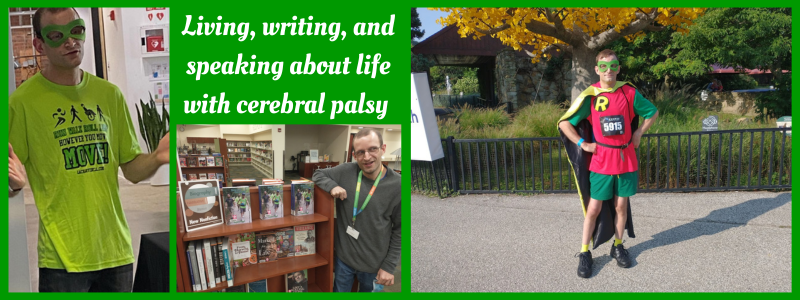
On April 12th I guest host the inclusive education chat #iechat to ask the teachers!
Inclusive education looks different for each student. Recent Twitter chats reinforced said fact. Chats I participated in. Today I share highlights from those.
Addressing Layers
Actually my roles in these aforementioned chats go beyond participant. First on Tuesday, April 12th I guest hosted #iechat. An inclusive education chat for teachers, #iechat happens Tuesdays at 8:30pm ET.
While I’m not an educator, I consider myself an advocate for the student’s voice. A role I fell into after publishing my teenage memoir Off Balanced. Therefore I designed questions to make teachers think about inclusive education from the student’s perspective.

Ever the opportunist I decided to re-phrase my questions for #CPChatNow. As you probably know by now I co-host #CPChatNow, a weekly cerebral palsy chat. By re-working my questions I aimed to gain students’ (current and past) perspectives.

Essentially I looked to address another layer to inclusive education!
A Reminder
Both conversations served as reminders to stay mindful when developing classroom strategies. For example, during #iechat I mentioned a strategy intervention specialist Anshawn Ivery uses. Ivery’s one-on-one conversations with students left a lasting impression on me once I interviewed him for The Mobility Resource.
However, a different educator pinpointed a potential flaw with the method. The educator stated, “@zacharyfenell Works great when Ss have expressive language – but Ss who don’t deserve to be included in the conversation too! #iechat”
Does that make Ivery’s tactic invalid? I think not. Instead I believe the point demonstrates how no one method proves universal. Thus the importance to knowing individual students! A #iechat participant shared helpful advice for creating positive teacher-student relationships.
@zacharyfenell The Power of Being Positive #iechat pic.twitter.com/RAcca13RqG
— T Dolezsar-Glarvin (@PrincipalMrsDG) April 13, 2016
Establishing this positive relationship should enable teachers to identify students’ learning styles. My #CPChatNow co-host Blake Henry mentioned the crucial learning styles.
Q3:A3:Differences need to b celebrated through variety of ways dependent on students learning style.Hands on, audio, visual etc #CPChatNow
— Blake Henry (@CPInspiration) April 14, 2016
Go Team!
Additionally a teamwork theme quietly emerged during the two Twitter chats. With the #iechat my second question led to the team component.
A2: Letting parents know that we have their child’s best interests at heart, that they are capable of living up to high expectations #iechat
— T Dolezsar-Glarvin (@PrincipalMrsDG) April 13, 2016
Using the team metaphor teachers can act as coaches. A good coach pushes his athletes to his or her limits. When you push limits, limits expand, Impossible becomes possible.
A2: #iechat parents underestimating their student’s ability. 1/2
— ParaEducate (@Paraeducate) April 13, 2016
A2: #iechat it isn’t mean, it is simply “I had no idea [that] was possible.” 2/2
— ParaEducate (@Paraeducate) April 13, 2016
Keep in mind the student belongs to the team also. #CPChatNow regular Devin Axtman raised that point in a tweet.
@zacharyfenell participating in IEPs, but I feel my school could’ve fostered more self advocacy #CPChatNow
— Devin (@AdventuresInCP) April 14, 2016
Share Your Inclusive Education Thoughts
Hopefully you found these varying thoughts on inclusive education beneficial. Add your own insights while here too! Does a certain question catch your attention? Go ahead and answer in the “Comments” section below.
Make sure you indicate the question which you answer. I look forward to reading your takes on inclusive education.


